It is not a case of eradicating weeds it is a case of managing or controlling them. The organic farmer does not have weeds just green mulch.
I look at weeds and if they are edible, they all of a sudden become a vegetable crop.

Everywhere you look, everything you read well meaning people are telling you to eradicate your weeds. Unless you build a totally enclosed garden and restrict visitors and remove every weed that germinates for the next 400 years the soil seed bank will still have more to disillusion, demoralize and destroy you will power. There is a chance of eradicating some weeds which have short seed viability or those that require many years to mature and reproduce the next off spring but really the chances of eradication are next to nothing.
There are now 460 different agricultural and Domestic weeds which have varying degrees of resistance to herbicides globally. Yet it was just a few decades ago we were being assured that herbicides were the answer to ridding the soil of weeds. Then a decade ago we were introduced to GM crops that could cope with stronger herbicides so that those weeds displaying resistance could be given even higher doses of toxic herbicides. The weeds are winning as they are evolving and are now becoming resistant to 22 of the 25 commercially permitted herbicides available sites of action and to 155 different herbicides on the market. Herbicide resistant weeds have been reported in 84 crops in 65 countries.
The new resistant strains are costing chemically induced farmers more every year in their feeble attempts to eradicate the weed yet organic farmers are coping without the use of such toxins available to them. The average garden has absolutely no chance without hours of arduous backbreaking labour. Leave that sort of thing to the manicured lawn slave and come join me and learn to love your weeds. That is weeds not weed.
Importance of Weed Control
Weed control not the elimination of weeds, as weeds in the orchard or with free range animals is an essential part of healthy crop production systems. Weeds reduce yields by competing with crops for water, nutrients, and sunlight, and may directly reduce profits by hindering harvest operations, lowering crop quality, and producing chemicals which are harmful to crop plants. Left uncontrolled, weeds may harbor insects and diseases and produce seed or rootstocks which infest the field and affect future crops. Despite expenditures for weed control being quite significant, the stress it causes farmers and gardeners is the same worldwide. It is estimated American crop losses where weeds are left uncontrolled exceed $8 billion annually.
Years of research have shown that good weed control within the first 4 to 6 weeks after crops are planted is critical in order to avoid a yield reduction from weeds. The effectiveness of any weed control program depends largely upon one factor – Timing. There are many cultural, mechanical, and chemical methods of weed control that are effective if applied at the correct time. Fields that are kept free of weeds for the first four to six weeks after planting give the crop a “head start” which enables it to shade out or out compete weeds that emerge later in the season.
Weed Control not Elimination
Weed control not the elimination of weeds, as weeds in the orchard or with free range animals is an essential part of healthy crop production systems. Weeds reduce yields by competing with crops for water, nutrients, and sunlight, and may directly reduce profits by hindering harvest operations, lowering crop quality, and producing chemicals which are harmful to crop plants. Left uncontrolled, weeds may harbor insects and diseases and produce seed or rootstocks which infest the field and affect future crops. Despite expenditures for weed control being quite significant, the stress it causes farmers and gardeners is the same worldwide. It is estimated American crop losses where weeds are left uncontrolled exceed $8 billion annually.
Years of research have shown that good weed control within the first 4 to 6 weeks after crops are planted is critical in order to avoid a yield reduction from weeds. The effectiveness of any weed control program depends largely upon one factor – Timing. There are many cultural, mechanical, and chemical methods of weed control that are effective if applied at the correct time. Fields that are kept free of weeds for the first four to six weeks after planting give the crop a “head start” which enables it to shade out or out compete weeds that emerge later in the season.
Let us now look at some of the alternatives and I mean chemical alternatives before we look at the way to go.
* Identify specific weed problems: Is 100mm control of all weeds necessary? Weed species vary greatly in their ability to compete with crops and reduce yields. The most successful farmers design control programs to maximize profits while gardeners wish to maximize relaxation therefore weed elimination is not necessary where as weed control is highly beneficial. While it is true that plants are able to tolerate a certain number of weeds without suffering a yield reduction, there are some weeds which need 100mm eradication for a number of reasons. They are too competitive for the plants being grown, persistent, have unwanted characteristics like thorns or burrs, look straggly or out of place, are poisonous, attract pests or secrete harmful chemicals which other plants are unable to cope with. Now decide on a program that suits your situation of elimination, reduction or control.
Follow nature and let the war begin
Let us now look at some of the alternatives and
I mean real alternatives to chemical control.
* Prevention and Management: This method is self explanatory. First plant the garden bed with the seedlings, trees and shrubs then cover the ground in a thick layer of mulch. Mixed mulches are generally the best or alternate the mulches annually or biannually. Start with finer nitrogen rich mulches to get the soil microbes working transferring to bulkier, higher carbon mulches as the garden progresses. This will increase the number of microbes and macro organisms like worms which will also dine on many smaller weed seeds like Parramatta Grass. The idea is to smother them. This will not eliminate the soil seed bank but will reduce the number of species especially those with short viability in the soil.
Alternatively fine weed free mulch can be laid on dry freshly prepared ground to a depth of 30mm to 50mm in depth. Sow the seeds into the mulch and only water the mulch. Be careful not to allow water to penetrate to the soil below. This method is extremely effective for farms that have a ready supply of clean weed free sawdust. The sawdust adds carbon to the soil, reduces nitrogen which also acts as a germinator suppressant and eliminates light for light sensitive seeds. The down side is once the seedlings roots reach the soil a quick nitrogen fix is required. This can be done by applying a liquid fertilizer like fish emulsion or liquid animal manures. We tried this by adding Hoods Blood and Bone over the dry soil prior to laying the sawdust. This is very effective if the soil is dry when the sawdust is laid and seed watering does not reach the soil until the seedlings roots reach the soil. The seedlings will take up the released nitrogen before the soil microbes have a chance to start working on the sawdust.
* Weed Management in Agro ecosystems is achieved by the correct timing of the reduction. Pre germination of desired specie seeds with a 50mm disturbance of the soil the day of planting the seeds will give the seeds that little extra start. This is very affective in the case of quick sprouting seeds and those with an aggressive tap root where the seedlings roots can reach the undisturbed moist soil below before any weed seeds are watered and commence growing.
Another method we deployed on the farm when growing seeds was the knock down method. The seeds are sown immediately after the field was rotary hoed. As the first seeds appear, take a gas burner with a jet designed to cover the whole bed and pass it quickly over the bed. This will eliminate all the seeds that have already emerged. This method is particularly effective on seeds that are slow at germinating compared to the weeds. The pass over needs to be slow enough to kill all the emergent seeds yet quick enough as not to simulate a fire and have fire dependant seeds germinate.
* Management of Invasive Plants in Natural Ecosystems or horticulture is much easier and while most people turn to chemicals many are now relying on mulches to smother weeds and to prevent which kills many seeds with short seed viability. Mulches also have the additional benefits of retaining moisture in the soil prevent excessive evaporation and add minerals to the soil which are essential to plant growth.
* The use of ground covers, desirable grasses, reeds and lilies offer the gardener an alternative means of competition where by the plants when densely planted have head starts over the weeds. These desirable plants out compete new seedlings which may germinate. Below is a four year old Citrus australisica, the Finger Lime, with a good crop. It is growing with Goodenia grandiflora, as our ground cover. Once the ground covers are established no additional nutrients are required and in fact they will replenish and recycle mulch and minerals.

* Hand tools usually mean hard work or in my case exercise. The Dutch Hoe or Chinese push hoe is probably one of the best hand tools available for the control of emergent weeds when no mulch is available or mass plantings have been incorporated into the scene to Control Weeds and Invasive Plants. The Dutch Hoe works best on light friable soils or where very fine mulches have been used like sawdust. The idea is to push and pull the hoe just below the surface of the soil or sawdust to disturb the weeds or sever the roots. It is best used mid morning to ensure the sun finishes the weeds off.

The shovel or mattock or McCleod Tool can be used to grub larger weeds and to dig holes for planting without disturbing the surrounding soil and setting off the germination of seeds over a larger area. The McCleod Tool is invaluable for grubbing larger areas and scraping larger weeds into paths or around plants without the need for bending over all the time.
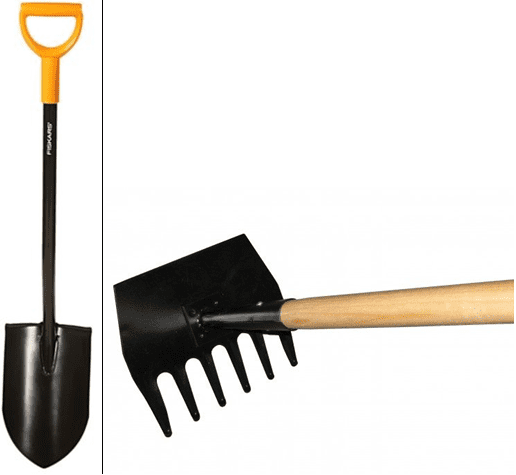
The whipper snipper is a great invention quick easy light weight and can cover a lot of ground. It is better used on soft weeds especially where they are needed for erosion control. The idea is to prevent flowering and seed set so is best used immediately after the first flowers appear unless seeding along fire breaks and the like ground is required. The whipper snipper is also very handy on small lawns and in awkward confined spaces. Often much quicker, easier and more efficient than a lawn mower.
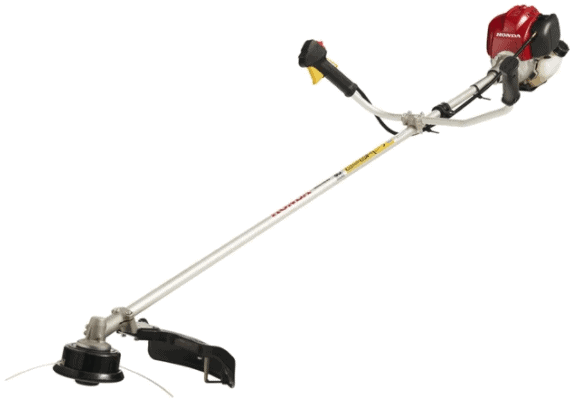
The effectiveness of a rotary hoe should not be underestimated when weeds are in the early stage of development, or just emerging from the soil. Cultivation with a shovel, sweep, or rolling cultivator is more effective than a rotary hoe on larger weeds, but should still be operated when weeds are very small. Cultivations should be shallow; 20mm to 40mm deep, to prevent excessive root damage to the crop, depletion of soil moisture, or excessive ridging, which can create problems for some crops.
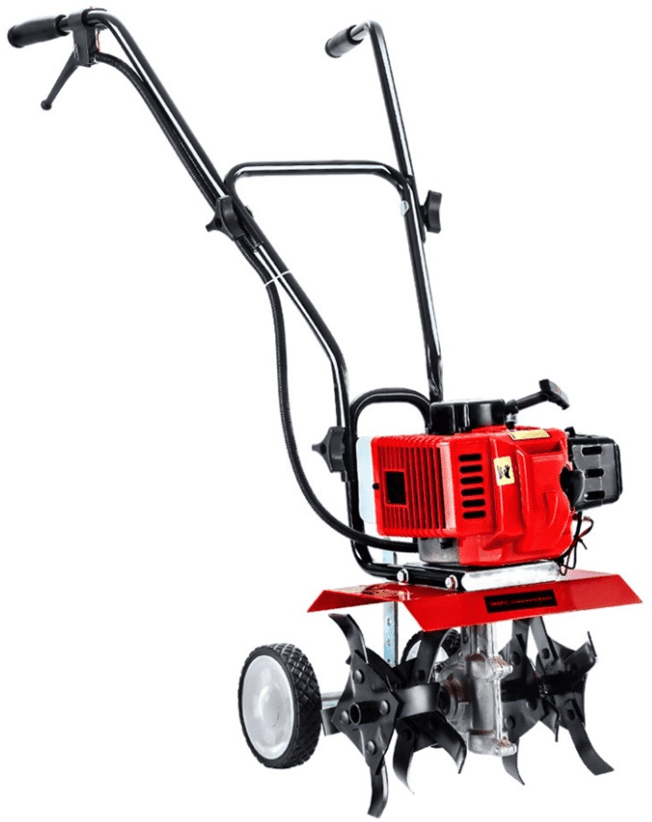
Conservation or reduced tillage systems do not involve moldboard plowing, and maintain the previous crop’s residue on the soil surface. Tillage in a reduced tillage system consists of using a disk, field cultivator, or chisel plow and is best applied just prior to planting.
No till crop production involves no primary or secondary tillage. The crop is planted directly into a sod or the previous year’s crop residue.
* Allelopathy affect on the soil in the best method of control. Pakistan has done a lot of research on allelopathy with the latest research results can be found at www.wssp.org.pk/article.htm
Allelopathy has proven to be extremely affective; on our property, in controlling weeds in small areas. The Pakistani results now indicate that it can be and will be applied to larger farms; by Pakistani standards, in the near future. Allelopathy is the layering of a layer of certain mulches on the bed between the crops grown. The difference between mulch and allelopathy is the source and the resistance the type of mulch plays in Suppressing Weeds. Instead of requiring 70mm to 120mm of random mulches, if an allopathy mulch is used then a layer of only 5mm to 10mm is required.
Bracken is a good example of allelopathy use. If you look below a field of bracken it appears sterile, a landscape of few or no weeds and little weeds. The layer of mulch is thin yet both the leaves and roots are releasing chemicals into the soil which suppress seed germination. If Bracken is grown on a plot for several years those seeds with short viability cease to germinate and those with longer viability must wait for a specific period after the bracken has been removed. It is these chemicals which are of interest to biochemists.
Another excellent native example can be found in many of the Casuarina and Allocasuarina specie. Here the leaves or rather articles play the role in suppressing the weeds. After a layer of around 5mm to 10mm of the articles have formed, weeds cease to germinate yet there is still sufficient light and moisture in the soil.
Both the above plants have been used in trial areas on our seed farm where seedlings were planted. The results with bracken were realised with layers of just 5mm in depth while depths of 8mm to 10mm of Allocasuarina littoralis were required. Below the two plants can be seen to supress weeds naturally eliminating competition for the trees and fern. We have deployed Allocasuarina littoralis in sections of our 10 acre block at The Pinnacles.
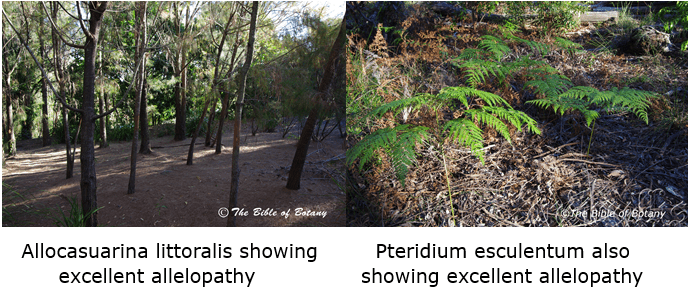
Plants inevitably grow in locations which are best suited to their needs. Forest species develop in rich fertile soils and overtime the plants growing in the forest change. This is because the plants are adding and reducing different minerals from the soil but all the time replacing what they took as they die. This changes the soils chemistry usually increasing the fertility and adding more carbon to the soil. A particular area that may have been well suited for growing Senecio magnificus for several years may now be more conducive for the growing of Commelina cyanea. Scientists can often tell the condition of a forest by the plants that are thriving and the annuals and perennials that are covering the forest floor. The same can be transposed into the garden or vegetable patch.
The general health or more accurately the state of a soil below the weeds; that are successful in competing for the available space, are tell signs of what is going on in the soil. Weeds are defined by most as “plants out of place” but are they? They are terrific indicators for the gardener to do something or often to do nothing. Safety, erosion control, water purification, water infiltration, atmospheric carbon sequestration and other environmental benefits are enhanced by those unwanted weeds.
The best defense against weeds in a healthy garden is mulch and plenty of it, because mulch suppresses not just the germination but makes it difficult for the weed to reach sunlight to commence growing. If they do manage to reach the surface they are easily pulled.
Nutrient deficiencies, nutrient excesses, soil compaction, acidic soils, excessive shade, excessive moisture, too sandy or too heavy a clay or even just right will give particular weeds a beneficial head start in life over more permanent plants. Most weeds are annuals grasses or reeds. Below is a list of some of the more common weeds including invasive foreign weeds that call Australia home.
When we first commenced planting our orchard we had very little growth and felt disheartened as we were hoping for a good mixed weed cover to get things moving. Large areas of nothing developed with Parramatta grass and the noxious exotic weed groundsel were to be seen in most other areas. These weeds were a sign that we had a compacted acid soil. Soil tests confirmed the extent of the acidity on the disused turf farm. Eventually some Paspalum specie grew along with the spreading of Haifu clover and Rye which we had sown began to grow weak and spindly. Despite the top dressing of saw dust lime and blood and bone and 12 months we still had little to show for our efforts. It was the following season that we had an amazing outbreak of the best Scotch Thistle anyone could imagine, the clover started to flourish and the ducks were kept busy eating the clover down which was now getting on top of them with Paspalum and millet. The bases on the thistles measured over 75mm in diameter with a heighty of over 2 meters in many instances. We were so excited, as the thistle was a great indicator the soil was in a transitional stage for the better or worse. With the lushness of the thistles we knew that the change was positive. Soon after the hard clay began to break up it was becoming friable. The thistle stage lasted for 2 seasons. The Parramatta Grass and exotic groundsel were now starting to reel under the pressure of the thistle and better cover crops which were thriving. The bare patches had disappeared and were now covered in a verdant green
Invasive weeds can interfere with local forest ecosystems especially to the detriment of local native grasses and greatly affect crop yields and pasture production of desirable plants.
Weeds and ‘sleeper weed’ in particular have major impacts on agricultural and natural environments throughout the world. Sleeper weeds are those invasive introduced or at times native plants that have naturalized in a region but as yet have not increased their population size exponentially as to cause a problem but have the potential to become a serious problem to the agriculturalist, gardener or natural environment’ In Australia, the cost of weeds to agricultural systems has been estimated at $3.3 billion per annum (Combellack 1987; Jones et al. 2000; Groves 2002) compared to the $2.4 billion estimated for salinity, sodicity and soil acidity combined (CRCAWM 2002). Australian farmers and gardeners consider weed control to be the highest priority in land usage. Sleeper weeds in Australia include Mimosa bush, a sleeper weed for 70 years before becoming a major weed. Pampas grass was a sleeper for decades before becoming a weed in the 1970s. Further sleeper weeds will occur as Global Warming extends awakening more passive weeds. It is best to control these weeds at an early stage before they erupt and begin to spread rampantly.
Biological control is often hailed as the answer to many weed outbreaks and has served Australia well with examples like the Cactus blastus moth in the control of prickly Pear and Miximitosis in the control of rabbits but has been equally disastrous with the release of the Cane Toad Bufus marina.
The major hurdles in biological controls are the time frame for analysing results, the problems with possible mutations arising in a foreign environment, the various climatic regions, the large number of possible hosts and the bipolar philosophical approaches of the various political parties in the country. Added to all this there is always a risk factor that something unbeknown occurs and the sensationalised and confrontational perspectives of the various players involved. Green Lace wing, Chrysoperla sp. are an excellent method in the control of aphids in the garden.
Organic Sprays?
If all else fails then the organic grower can resort to an excellent non selective spray made from every day cooking items. Non selective refers to the fact that it will destroy the chlorophyll in all living green matter it comes in contact with. So be careful not to let the spray contact your loved plants.
A good organic spray can be made by using 2 litres of double strength Acetic Acid (vinegar) with 75 grams of ascorbic acid (citric acid Vitamin C) and a good squeeze of dishwashing liquid (Can be diluted with 30mm water on good hot clear days). The dish washing liquid aids in the solution in sticking to the leaves. Shake the ingredients together and apply in the morning of a sunny day. Sun light ensures a quick kill. Within an hour the chlorophyll (The green within the leaves and stems) would be destroyed and the by days end the weeds would have succumbed totally. Be careful as the spray is none selective and will kill all green matter in comes in contact with. For large areas the vinegar can be purchased in bulk at wholesale prices at 5x the strength and diluted down as above.
Larger weeds and weeds with underground tubers may need a couple of sprays a week or several days later.


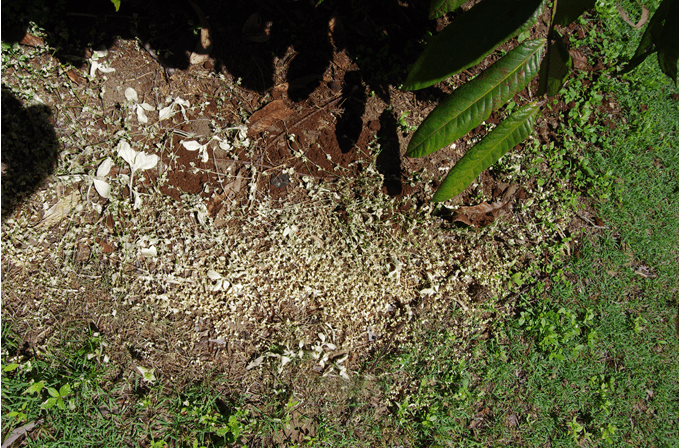
Please note that this is a non selective spray and it will kill whatever green foliage it comes into contact with. While it may not kill your trees or shrubs it can severely defoliate them and set them back a few weeks or perhaps months. The spray is best used where full sunlight is received or when the weeds are in full sun. Note full death above occurred in less than two and a half hours. The spray can be washed off plants immediately if it is spilt or drift occurs. Once the ascorbic acid and citric acid touches the ground it will begin to break down as all organic matter does unlike that of hostile toxic chemical.
Weeds Associated with Different Soil Problems
Acid soil: Sorrel (Rumex species), sow thistle (Sonchus sp.) prostrate knotweed (Polygonum aviculare) lady’s thumb (Polygonum persicaria), wild strawberries (Fragaria sp.), plantain (Plantago major), Groundsel Senicio sp.) and bentgrasses (Agrostis species).
Alkaline soil: Field peppergrass (Lepidium virginicum), goosefoot (Chenopodium sp.), gromwell (Lithospermum officinale) and chamomile (Anthemis nobilis).
Wet or poorly drained soil: Sedges (Carex sp.), lady’s thumb (Polygonium perscaria) joe-pye weed (Eupatorium purpureum), silvery cinquefoil (Potentilla argentea), curly dock
(Rumex crispus), mosses, buttercups (Ranunculus sp.),sheep sorrel (Rumex acetosella), annual bluegrass (Poa sp.), common chickweed (Stellaria media), crabgrass (Digitaria sp.), goosegrass (Elusine sp.), ground ivy (Glechoma hederacea), mouse ear chickweed (Cerastium vulgatum), native violets (Viola banksii or Viola betonicifolia), yellow nut sedge (Cyperus esculatus)
Dry soil: Virginia pepperweed (Lepidium virginicum), rough cinquefoil (Potentilla monspeliensis), potato vine (Ipomoea pandurata), yarrow (Achillea millefolium), black medic (Medicago lupulina), red sorrel (Rumex acetosella).
Compacted or heavy soil: wild garlic (Allium vineale) dandelion (Taraxacum officinale), broadleaf dock (Rumex obtusifolius), creeping buttercup (Ranunculus repens), plantain (Plantago major), annual bluegrass (Poa specie), common chickweed (Stellaria media) goosegrass (Elusine indica), knotweed (Polygonum aviculare), mouse ear chickweed (Cerastium vulgatum), prostrate spurge (Euphorbia supina).
Soil with a hardpan or hard crust: horse nettle (Solanum carolinense), pennycress (Thiaspi arvense), quack grass (Agropyron repens), field mustard (Brassica nigra), morning-glory (Ipomoea purpurea).
Previously cultivated soil: Lamb’s-quarters (Chenopodium album), plantain (several sp.), ragweed (Ambrosia artemisiifolia), purslane (Portulaca oleracea), dandelion (Taraxacum officinale), chickweed (Stellaria media), and pigweeds ( Amaranthus sp.).
High fertility soil: chicory (Cichorium intybus), pigweeds (family Amaranth), purslane (Portulaca oleracea), dandelion (Taraxacum officinale), lamb’s quarters (Chenopodium album), burdock (Arctium minus), pokeweed (Phytolacca americana), butter print (Abutilon theophrasti), Queen Anne’s lace (Daucus carota), annual bluegrass (Poa specie), bentgrasses (Agrostis species), yellow wood sorrel (Oxalis stricta), crabgrass (Digitaria species), mallow (Malva neglecta) and purslane (Portulaca oleracea)
Low fertility soil: plantains (Plantago species), red sorrel (Rumex acetosella) and white clover (Trifolium repens)
Shaded soil: annual Bluegrass (Poa annua), chickweed (Stellaria media) and violets (Viola betonicifolia or Viola banksii)
Low Potassium & low phosphate soils: bracken (Pteridium esculentum).Nettles: Usually better quality, high nitrogenous. High phosphate, tilled soils or disturbed soils old dairies chicken farms, piggeries etc. (Urtica incise or Urtica dioica)
Further Comments from Readers:
All information is included in good faith and has been thoroughly researched prior to printing. The website or the author does not warrant or guarantee the accuracy of any information on these pages, nor does the website or the author accept any responsibility for any loss arising from the use of the information found within. The views and opinions are strictly those of the author or those members who chose to actively, participate in the contents herein.
“Hi reader, it seems you use The Bible of Botany a lot. That’s great as we have great pleasure in bringing it to you! It’s a little awkward for us to ask, but our first aim is to purchase land approximately 1,600 hectares to link several parcels of N.P. into one at The Pinnacles NSW Australia, but we need your help. We’re not salespeople. We’re amateur botanists who have dedicated over 30 years to saving the environment in a practical way. We depend on donations to reach our goal. If you donate just $5, the price of your coffee this Sunday, We can help to keep the planet alive in a real way and continue to bring you regular updates and features on Australian plants all in one Botanical Bible. Any support is greatly appreciated. Thank you.”
In the spirit of reconciliation we acknowledge the Bundjalung, Gumbaynggirr and Yaegl and all aboriginal nations throughout Australia and their connections to land, sea and community. We pay our respect to their Elders past, present and future for the pleasures we have gained.